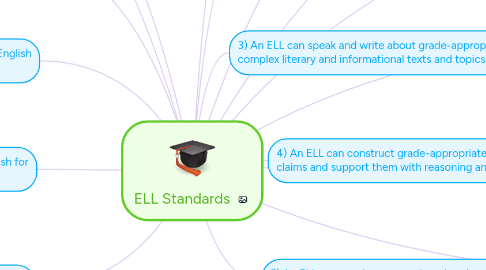ELL Standards
by Kenneth Theodos

1. 5)Students will demonstrate cross-cultural knowledge and understanding.
1.1. Teaching Strategy: Ask students to role-play from a story so they can understand the character's feelings. Ask students to share what they are feeling like and thinking about and relate this to personal experiences. This allows students to relate to their own cultures, become aware of other cultures and expand their knowledge and understanding.
2. NEW YORK STANDARDS
3. 1) Students will listen, speak, read, and write in English for information and understanding.
3.1. Teaching Strategy: Students listen to a book, then are divided into different groups to complete activities. One group plays a matching game, another group matches pictures as the teacher calls out terms, a third group matches terms and definitions via a fill in blank worksheet. This differentiated instruction tests for comprehension
4. 2) Students will listen, speak, read, and write in English for literary response, enjoyment, and expression.
4.1. Teaching Strategy: After students listen to a story, ask them to respond to events through drawings, action, or song. This allows students the opportunity to express themselves while demonstrating comprehension.
5. 3) Students will listen, speak, read, and write in English for critical analysis and evaluation.
5.1. Teaching Strategy: Give students an opportunity to write down opinions about characters in a story. They must present their opinions and justify them to the class as well as respond to rebuttals by classmates. This makes students evaluate what they are reading and tests for comprehension.
6. 4) Students will listen, speak, read, and write in English for classroom and social interaction.
6.1. Teaching Strategy: Give students a scenario they have to work through in pairs. Students will come up with solution and then create another solution for a different pair to solve. This tests student's ability to understand a process and requires them to interact.
7. 1) An ELL can construct meaning from oral presentations and literary and informational text through grade-appropriate listening, reading, and viewing
7.1. Teaching Strategy: Give student various activities to test comprehension, such as questions and answers or having them retell stories and share their experiences.
8. OHIO STANDARDS
9. 2) An ELL can participate in grade-appropriate oral and written exchanges of information, ideas, and analyses, responding to peer, audience, or reader comments and questions.
9.1. Teaching Strategy: Ask students to form an opinion on a story or character and share with the class. Ask someone to share their experience and articulate what the other student was referencing
10. 3) An ELL can speak and write about grade-appropriate complex literary and informational texts and topics.
10.1. Teaching Strategy: Ask students to write a summary about a section they read from memory.
11. 4) An ELL can construct grade-appropriate oral and written claims and support them with reasoning and evidence.
11.1. Teaching Strategy: Ask students to form an opinion on a story or character and share with the class. Ask someone to share a different opinion. Ask the students to defend their opinions knowledge and reasoning.
12. 5) An ELL can conduct research and evaluate and communicate findings to answer questions or solve problems.
12.1. Teaching Strategy: Students are given an assignment where they need to gather and summarize information
13. 6) An ELL can analyze and critique the arguments of others orally and in writing
13.1. Teaching Strategy: Build off the strategy in standard 4, but require the students to critique the other person's argument out loud and in writing
14. 7) An ELL can adapt language choices to purpose, task, and audience when speaking and writing.
14.1. Teaching Strategy: Ask students to share some common words related to culture that they might hear on the street and compare that to language or words they would use in the classroom or in more formal setting. Ask them to explain how the language and purpose are related.
15. 8) An ELL can determine the meaning of words and phrases in oral presentations and literary and informational text
15.1. Teaching Strategy: Ask students to list words they don't know and what clues they can use to determine meaning.
16. 9) An ELL can create clear and coherent grade-appropriate speech and text
16.1. Teaching Strategy: Ask students to retell events in sequential order in writing and then write their own paragraph based on personal experiences.
17. 10) An ELL can make accurate use of standard English to communicate in grade-appropriate speech and writing
17.1. Teaching Strategy: Have students answer uestions or respond to a prompt without error.


